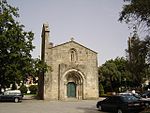Casa-Museu Marta Ortigão Sampaio
The Casa-Museu Marta Ortigão Sampaio (Marta Ortigão Sampaio's House Museum) is a small museum located in the city of Porto, Portugal. Marta was born in Porto into an upper-class family in end of 19th century, her father being a prominent intellectual, Vasco Ortigão Sampaio. She never actually lived in this house; her husband died prematurely during the construction of the house. Instead, she remained in the neighboring city of Matosinhos and became a collector of art in the vibrant bourgeois environment of Porto of the 19th century. The house exhibits impressive pieces of furniture as well as jewelry, painting and other art objects, including works of the Portuguese painters Silva Porto, Aurélia de Souza, Sofia Martins de Sousa and Marques de Oliveira.
Excerpt from the Wikipedia article Casa-Museu Marta Ortigão Sampaio (License: CC BY-SA 3.0, Authors).Casa-Museu Marta Ortigão Sampaio
Rua de Nossa Senhora de Fátima, Porto Cedofeita (Cedofeita, Santo Ildefonso, Sé, Miragaia, São Nicolau e Vitória)
Geographical coordinates (GPS) Address Nearby Places Show on map
Geographical coordinates (GPS)
| Latitude | Longitude |
|---|---|
| N 41.1593 ° | E -8.6255 ° |
Address
Rua de Nossa Senhora de Fátima 307
4050-428 Porto, Cedofeita (Cedofeita, Santo Ildefonso, Sé, Miragaia, São Nicolau e Vitória)
Portugal
Open on Google Maps









